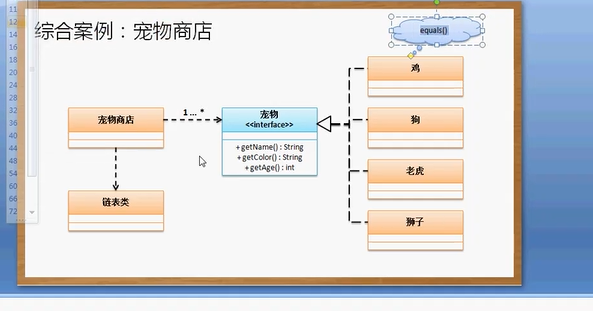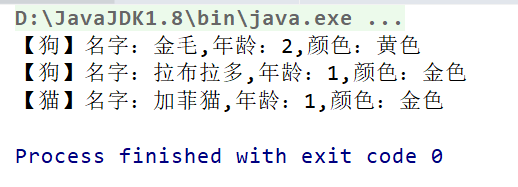宠物商店
现在要求建立宠物商店,里面就有进行要销售宠物的上架,下架,关键字查询。
要求:描述出程序的关系即可
那么假设对于宠物的信息只要求有三项:名字,年龄,颜色
那么此时对于的关系:一个宠物商店会有多种宠物。如果按照关系表来讲这是一对多的关系映射,但是现在的问题是,一方是宠物商店,而多方应该是宠物,但是宠物又分为猫,狗,猪,鱼 等等。 
1.创建链表
public interface ILink<E> { // 设置泛型 public void add(E e); // 添加数据 public int size(); // 获取数据的个数 public boolean isEmpty(); // 判断是否空集合 public Object[] toArray(); // 将集合元素以数组的形式返回 public E get(int index); // 根据索引获取数据 public void set(int index, E data); // 修改索引数据 public boolean contains(E data); // 判断数据是否存在 } /** * @author Gu * @cracked 2020-03-25 9:24 */ class LinkImpl<E> implements ILink<E> { // 负责链表的操作 // 将Node定义为内部类,表示Node类只为Link类 private class Node { // 负责数据与节点关系的匹配 private Object data; // 保存节点的数据 private Node next; // 保存下一个节点 public Node(Object data) { this.data = data; } // 第1次调用:this = Link.root // 第2次调用:this = Link.root.next; // 第3次调用:this = Link.root.next; public void addNode(Node newNode) { // 处理节点关系 if(this.next == null) { //当前节点下一个为空 this.next = newNode; }else{ // 现在当前节点的下一个不为空 this.next.addNode(newNode); } } // 第一次调用:this = Link.root // 第一次调用:this = Link.root.next public void toArrayNode() { LinkImpl.this.retData[LinkImpl.this.foot++] = this.data; if(this.next != null){ // 现在还有下一个节点 this.next.toArrayNode(); } } // 第一次调用:this = Link.root // 第一次调用:this = Link.root.next public boolean containsNode(Object search) { if(search.equals(this.data)){ // 找到了 return true; }else { if(this.next != null) { // 当前节点之后 return this.next.containsNode(search); }else { // 没有节点 return false; } } } // 第一次调用: this = Link.root // 第一次调用: this = Link.root.next public Object getNode(int index){ if(LinkImpl.this.foot++ == index) { return this.data; }else { this.next.getNode(index); } return null; } public void setNode(int index,Object newData) { if(LinkImpl.this.foot++ == index) { // 索引相同 this.data = newData; return ; // 结束 }else { if(this.next != null) { this.next.setNode(index,newData); } } } // 第一次调用:this = Link.root.next,previous = Link.root; // 第二次调用:this = Link.root.next.next,previous = Link.root.next; public void removeNode(Node previous,Object data) { if(this.data.equals(data)) { // 当前节点为要删除节点 previous.next = this.next; // 删除当前了 }else { this.next.removeNode(this,data); } } } //----------------以下为link类------------// private Object[] retData; // 返回类型 private int foot = 0; // 操作脚标 private int count = 0; // 当前的保存个数 private Node root; // 属于根节点,没有根节点就无法进行数据的保存 public void add(Object data) { if(data == null) {// 人为的追加了规定,不允许存放空值 return ; // 方法结束调用 } // 如果要想进行数据的保存,那么就必须将数据封装在Node节点类里面 // 如果没有封装,则无法确认好节点的先后顺序 Node newNode = new Node(data); if(this.root == null) { // 当前并没有根节点 this.root = newNode; // 第一个节点设置为根节点 }else{ // 根节点已经存在了 // 应该把此时的节点顺序的处理交给Node类自己完成 this.root.addNode(newNode); } count++; } public int size() { // 取得元素个数 return this.count; } public boolean isEmpty() { return this.root == null && this.count == 0; } public boolean contains(Object search) { // 没有要查询的内容以及链表为空 if(search == null || this.root == null) { return false; } return this.root.containsNode(search); } public Object[] toArray() { if(this.count == 0) { return null; } // 现在链表中存在有数据,则开辟指定长度的数组 // 该数组一定要交给Node类进行处理 this.retData = new Object[this.count]; this.foot = 0; // 进行清零的处理,需要进行脚标操作 this.root.toArrayNode(); // 将数据的取出处理交给Node类完成 return this.retData; } public void set(int index,Object newData) { if(index >= this.count){ // 超过了保存的个数 return ; // 结束方法调用 } this.foot = 0; this.root.setNode(index,newData); } public E get(int index) { if(index >= this.count){ // 超过了保存的个数 return null; } this.foot = 0; return (E) this.root.getNode(index); } public void remove(Object data) { if(this.contains(data)){ // 如果该数据存在则进行删除处理 // 首先需要判断要删除的是否为根节点数据 if(this.root.data.equals(data)) { // 首先需要判断 this.root = this.root.next; // 根节点变为下一个节点 }else { // 不是根节点 this.root.next.removeNode(this.root,data); } this.count--; } } }
2.建立宠物标准
// 定义宠物 interface Pet { public String getName(); public String getColor(); public int getAge(); }
3.对于宠物商店,只关注于宠物的标准,而不关心那种宠物
/** * @author Gu * @cracked 2020-03-25 9:10 */ public class PetShop { private LinkImpl pets = new LinkImpl(); //开辟一个链表,保存多个宠物 public void add(Pet pet) { // 上架上的宠物, this.pets.add(pet); } public void delete(Pet pet) { this.pets.remove(pet); } public LinkImpl getPets() { // 取得全部宠物 return this.pets; } public LinkImpl search(String keyWord) { LinkImpl result = new LinkImpl(); // 保存查询结果 Object[] data = this.pets.toArray(); for(int x = 0; x < data.length; x++) { Pet pet = (Pet)data[x]; if(pet.getName().contains(keyWord) || pet.getColor().contains(keyWord)) { result.add(pet); // 满足查询结果 } } return result; } }
4.定义宠物狗:
public class Dog implements Pet { private String name; private int age; private String color; public Dog(String name,int age,String color) { this.name = name; this.age = age; this.color = color; } public String getName() { return this.name; } public int getAge() { return this.age; } public String getColor() { return this.color; } public boolean equals(Object obj) { if(obj == null) { return false; } if(this == obj) { return true; } if(!(obj instanceof Dog)) { return false; } Dog pet = (Dog)obj; return this.name.equals(pet.name) && this.age == pet.age && this.color.equals(pet.color); } public String toString(){ return "【狗】名字:"+this.name+",年龄:"+this.age+",颜色:"+this.color; } }
5.定义宠物猫
public class Cat implements Pet { private String name; private int age; private String color; public Cat(String name,int age,String color) { this.name = name; this.age = age; this.color = color; } public String getName() { return this.name; } public int getAge() { return this.age; } public String getColor() { return this.color; } public boolean equals(Object obj) { if(obj == null) { return false; } if(this == obj) { return true; } if(!(obj instanceof Cat)) { return false; } Cat pet = (Cat)obj; return this.name.equals(pet.name) && this.age == pet.age && this.color.equals(pet.color); } public String toString() { return "【猫】名字:"+this.name+",年龄:"+this.age+",颜色:"+this.color; } }
6.编写测试程序
public class MainTest { public static void main(String[] args) { PetShop ps = new PetShop(); // 添加宠物 ps.add(new Dog("黑狗",1,"黑色")); ps.add(new Dog("金毛",2,"黄色")); ps.add(new Dog("腊肠",1,"金色")); ps.add(new Dog("拉布拉多",1,"金色")); ps.add(new Cat("加菲猫",1,"金色")); ps.add(new Cat("波斯猫",1,"白色")); // 删除宠物 ps.delete(new Dog("腊肠",1,"金色")); LinkImpl all = ps.search("金"); Object[] data = all.toArray(); for(int x = 0; x < data.length; x++) { System.out.println(data[x]); } } }
7.测试结果

实际之中这种形式的代码在生活中处处可见
一个公园可以有多种植物;
动物园可以有多种动物;
一个衣柜可以有多件衣服;
一个人可以吃多种食物;
总结:
在以后的代码开发过程之中一切都要以接口设计为主。